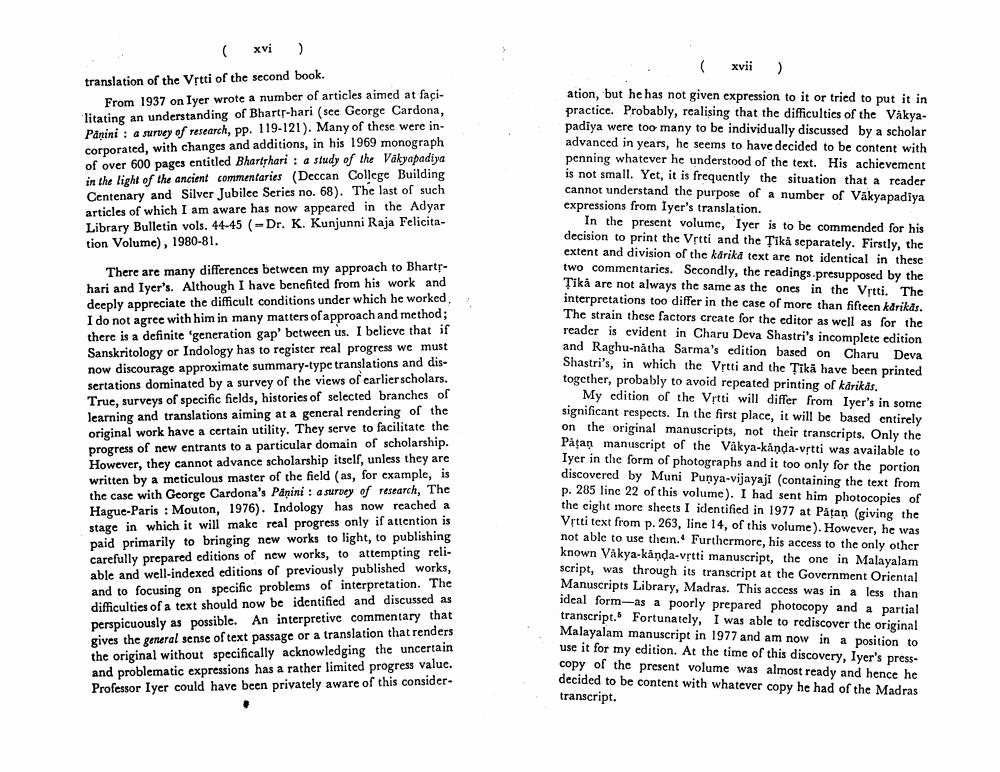Book Title: Foreword Author(s): Ashok Aklujkar Publisher: Ashok Aklujkar View full book textPage 5
________________ ( xvi ) translation of the Vrtti of the second book. From 1937 on Iyer wrote a number of articles aimed at facilitating an understanding of Bharts-hari (sce George Cardona, Panini : a survey of research, pp. 119-121). Many of these were incorporated, with changes and additions, in his 1969 monograph of over 600 pages entitled Bharthari : a study of the Vakyapadiya in the light of the ancient commentaries (Deccan College Building Centenary and Silver Jubilee Series no. 68). The last of such articles of which I am aware has now appeared in the Adyar Library Bulletin vols. 44-45 (-Dr. K. Kunjunni Raja Felicitation Volume), 1980-81. There are many differences between my approach to Bharthari and Iyer's. Although I have benefited from his work and deeply appreciate the difficult conditions under which he worked I do not agree with him in many matters of approach and method; there is a definite 'generation gap' between us. I believe that if Sanskritology or Indology has to register real progress we must now discourage approximate summary-type translations and dissertations dominated by a survey of the views of earlier scholars. True, surveys of specific fields, histories of selected branches of learning and translations aiming at a general rendering of the original work have a certain utility. They serve to facilitate the progress of new entrants to a particular domain of scholarship. However, they cannot advance scholarship itself, unless they are written by a meticulous master of the field (as, for example, is the case with George Cardona's Panini: a survey of research, The Hague-Paris : Mouton, 1976). Indology has now reached a stage in which it will make real progress only if attention is paid primarily to bringing new works to light, to publishing carefully prepared editions of new works, to attempting reliable and well-indexed editions of previously published works, and to focusing on specific problems of interpretation. The difficulties of a text should now be identified and discussed as perspicuously as possible. An interpretive commentary that gives the general sense of text passage or a translation that renders the original without specifically acknowledging the uncertain and problematic expressions has a rather limited progress value. Professor Iyer could have been privately aware of this consider ( xvii ) ation, but he has not given expression to it or tried to put it in practice. Probably, realising that the difficulties of the Vakyapadiya were too many to be individually discussed by a scholar advanced in years, he seems to have decided to be content with penning whatever he understood of the text. His achievement is not small. Yet, it is frequently the situation that a reader cannot understand the purpose of a number of Vakyapadiya expressions from Iyer's translation. In the present volume, Iyer is to be commended for his decision to print the Vetti and the Tika separately. Firstly, the extent and division of the karika text are not identical in these two commentaries. Secondly, the readings.presupposed by the Țiká are not always the same as the ones in the Vrtti. The interpretations too differ in the case of more than fifteen karikas. The strain these factors create for the editor as well as for the reader is evident in Charu Deva Shastri's incomplete edition and Raghu-natha Sarma's edition based on Charu Deva Shastri's, in which the Vrtti and the Tikā have been printed together, probably to avoid repeated printing of kårikås. My edition of the Vrtti will differ from Iyer's in some significant respects. In the first place, it will be based entirely on the original manuscripts, not their transcripts. Only the Patan manuscript of the Vakya-kanda-vrtti was available to Iyer in the form of photographs and it too only for the portion discovered by Muni Punya-vijayaji (containing the text from p. 285 line 22 of this volume). I had sent him photocopies of the eight more sheets I identified in 1977 at Patan (giving the Vrtti text from p. 263, line 14, of this volume). However, he was not able to use thein. Furthermore, his access to the only other known Vakya-kända-vrtti manuscript, the one in Malayalam script, was through its transcript at the Government Oriental Manuscripts Library, Madras. This access was in a less than ideal form-as a poorly prepared photocopy and a partial transcript. Fortunately, I was able to rediscover the original Malayalam manuscript in 1977 and am now in a position to use it for my edition. At the time of this discovery, Iyer's presscopy of the present volume was almost ready and hence he decided to be content with whatever copy he had of the Madras transcript.Page Navigation
1 ... 3 4 5 6
